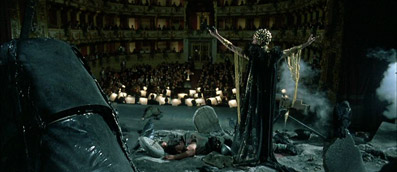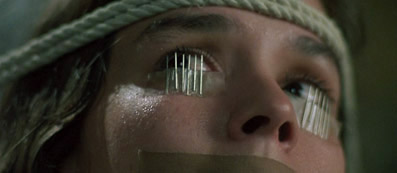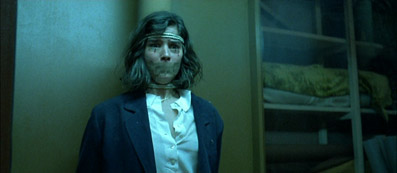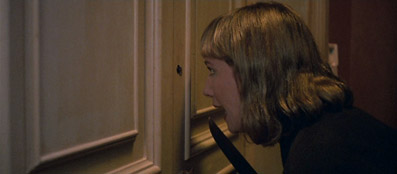|
You've got to love Dario Argento. He's far from the only giallo director of note, but there are good reasons why he's still widely regarded as top dog of this particular sub-genre. He's also one of the few Italian horror filmmakers whose name is known outside the confines of genre fandom, and as far as I'm aware his glorious 1977 Suspiria was the only Italian giallo film to secure a full blown UK nationwide cinema release alongside American studio pictures of the time. This was a golden period for giallo horror and Argento in particular, who was hitting home runs with every film – Suspiria followed Deep Red [Profondo rosso] (1975) and was succeeded by Inferno (1980) and Tenebre (1982), remarkable genre movies all. Opinion was split on the 1985 Phenomena, but in 1987 he made Opera, aka Terror at the Opera, and despite a string of production problems, the general view was that the finished film saw Argento back at the top of his game.
You'll find plenty of evidence of this in the film's opening fifteen minutes, which are as stylish and fluid as anything in the director's filmography. After a credit sequence in which the troubled rehearsal for a modern version of Verdi's Macbeth plays out under close-ups of a cawing raven, the opera's diva Mara Cecova sweeps from the auditorium in a gorgeously executed Steadicam reverse POV shot, pursued by concerned associates and admirers, and is pomptly knocked down by a car. At no time do we even glimpse her face.

Understudy Betty is immediately thrust into the lead role. Her first night proves a resounding success, but her performance is observed from a seemingly empty box seat by an unseen figure, who murders an usher by repeatedly impaling the back of his head onto a brass coat hook. Ouch. Later that evening, after another unsuccessful attempt to enjoy sex with her boyfriend Stefan at his opulent apartment, Betty is grabbed and tied up by a hooded figure. The intruder tapes needles under her eyes to prevent her from closing them, then brutally stabs Stefan to death, then cuts Betty free and departs.
It's about here that Argento the master showman almost trips over Argento the storyteller, as Betty recovers from this traumatic experience faster than most people could digest coffee. She's probably in a state of shock or denial, but there's nothing in Argento's handling or Cristina Marsillach's otherwise solid performance to suggest this is the case. Later revelations regarding the source of her recurring nightmare do not make her behaviour retrospectively convincing. For confirmed giallo fans this will not be an issue, as logic and common sense are almost always secondary to mood, style and set-pieces in this particular sub-genre, and you'll find all three here in abundance.
Visually, Opera is an intermittent stunner, thanks to Nicola Pecorini's free-floating Steadicam work, Davide Bassan's baroque production design, and Ronnie Taylor's fabulously expressive scope cinematography, which peaks with a genuinely astonishing POV shot of a raven circling over the heads of an opera audience. The murders all deliver on creative gore, and grisly sound effects make even an off-screen mutilation feel every bit as horrible as anything you actually see. One death in particular, involving a spy hole, a police pistol and a telephone, must rank as one of the director's most visually striking screen murders, perverse as that may sound. The use of opera music to build tension and narrative momentum is supremely effective, but the switch to pounding heavy rock for the killings feels like an encouragement to side with the aggression and sadism of the killer rather than the terror of the victims, being just the sort of music that young US troops have admitted to playing to hype themselves up for combat in the Middle East.*

The needles taped under the eyes are a typically perverse Argento touch (apparently inspired by his frustration at audience members who look away from his films during the violent scenes) but as a grand guignol take on the Ludovico treatment they don't look all that effective, being too far from the eyeballs to prevent eyelid closure and working better as a method of squint prevention. It's still an impressively nasty idea and must have had those charged with designing the promotional artwork hugging themselves with glee.
Whether or not you buy into the numbing effect of Betty's dormant emotional issues (and there's a persuasively put case for doing so in the IMDb user reviews), Opera still stands as one of Argento's most stylish achievements and is regarded by some as his last great giallo work, despite fan enthusiasm for The Stendhal Syndrome. Not everything makes complete sense, and non-giallo fans will find plenty to pick holes in, but on the components that count it delivers in visually sumptuous and blood-spattered spades.
Disc 1 contains the International cut of the film, while disc 2 has the edit of the film prepared for the American market, which is almost twelve minutes shorter. The cuts are not to the violence, but trims have been made to character scenes, presumably to accelerate the pace. This does result in some unfortunate losses, with costumer Julia now not appearing until just before she's attacked, and there's no second appearance for Alma's mother following Betty's escape through the air vent. I've probably missed a couple, but here's a list of the cuts and alterations I spotted:
- Anglicised opening credits;
- The sequence following Mara's accident has been shortened by a couple of shots;
- The backstage activity on Betty's first night has been trimmed by several shots;
- The first part of the POV Steadicam track up to the box seat is missing;
- A couple of shots of the audience have been snipped;
- One shot of Betty singing and one of the opera glasses immediately following the first flashback are missing;
- The murder of the usher and the falling light is slightly shorter;
- Mara angrily reacting to Betty's first night success on TV is gone, eliminating her as a potential suspect;
- An exterior shot of the dressing room and Betty's first meeting with Julia have been removed;
- The second half of the exchange between Stefan and Betty in the latter's dressing room has been removed, as has the delivery of a gift of foul smelling perfume from Mara, its disposal, and Julia's entrance and reaction to the smell – this is one of the biggest single cuts;
- An apartment conversation between Marco and his girlfriend over the first night reviews has been lost;
- Small changes have been made to the editing rhythm when Inspector Santini questions Marco and the cast;
- Betty walking to the costume store and a conversation she has with Julia before finding the bracelet are both gone;
- All imagery of blood vessels, skin and a throbbing brain just before Betty is attacked in the wardrobe store has been removed;
- The sequence in which Julia closely examines the bracelet has been shortened at the front end;
- Betty's conversation with Alma in the air vent has been trimmed, as has the action that follows;
- Betty walking downstairs with Alma and being turfed out by Alma's unfriendly mother is gone;
- A short sequence of Betty returning to her apartment is missing, losing a symbolic shot of a hanging bird mobile;
- The climactic opera has been slightly trimmed at the front end;
- The build-up to the spectacular flying POV shot has been shortened;
- The final sequence involving a lizard has been lost.
A solid 2.35:1 anamorphic transfer that in the best looking footage scores on the big three of colour, sharpness and contrast, although there is some inconsistency to the latter, with small but visible variations that see black levels occasionally slip towards grey. Grain is evident throughout but has not been digitally bumped up, and the prints of both cuts are clean. The palette displays a slight green/brown bias in some scenes, but this may well have been intended.

Three separate and distinctly different audio tracks have been provided for the international version of the film, two of which also appear on the US version. All three are fascinating for comparison purposes, but are not without their issues. The first thing to note is that all three have been post-dubbed, a common practice in Italian and especially giallo cinema, particularly when you have a multi-national cast performing in a mixture of English and Italian. This does mean that whichever language you select, there are going to be mismatches of dialogue to mouth movements. and in some instances voices that clearly do not belong to the faces in question. The Italian track serves the support cast well, but the leads have clearly performed their roles in English, and it's thus the English track that work's the best for me. Well, sort of.
There are two English tracks on the international version, a redubbed 5.1 surround track and a stereo dub that apparently provoked audience laughter when the film was screened at Cannes, and is thus referred to on disc 2 as "The Cannes track." It's nowhere near as bad as this rep suggests and much is re-used for the 5.1 redub, but there are definitely some questionable choices here, particularly the odd voice assigned to the square-jawed Inspector Santini. The Cannes track is louder than the 5.1, but at the expense of some clearly audible background hiss. The 5.1 dub has better voice acting and is sonically superior, but is inexplicably afflicted with an intermittent echo on much of the dialogue and some of the sound effects, making it sound like the film is playing in a large and empty warehouse. The US edit features the Cannes track and the redub, but the redub is stereo rather than surround.
The Italian track is Dolby 2.0 surround and a little more excitable due to the increased speed of the dialogue delivery. A couple of the voices do not acoustically match the location, but it's clearer than the English stereo track and has no obvious background hiss. Music elements aside, there's very little happening in the rear speakers on any track, but frontal separation is very nice, with some effects specifically placed and moving fluidly across the front sound stage.
All of the DVD extras are on Disc 1.
Dario Argento Trailer Reel (39:27)
Back-to-back trailers for The Bird With the Crystal Plumage, Cat O' Nine Tails, Four Flies on Grey Velvet (the voice-over on this one's a hoot), Le cinque gionate (a collection of stills cut to The William Tell Overture), Deep Red (hoorah!), Suspiria (how has a film this visually stunning ended up with a trailer constructed entirely from stills?), Inferno (this is more like it), Tenebre, Phenomena, Opera, Two Evil Eyes, Trauma, The Stendhal Syndrome, Phantom of the Opera, Sleepless, The Card Player, Mother of Tears and Dawn of the Dead (well he was the producer).

Dario Argento Biography and Filmography
As the title says, but the biography is short, the director filmography incomplete, and there's no mention of his writing or producing credits.
Top Six Gore Scenes (6:44)
Hmm. The six goriest scenes in the film edited together for us to drool over. Not much of an extra since all six are in the main feature and there are chapter stops located near the start of most of them.
Photo Gallery (1:15)
A rolling gallery of 15 not-that-interesting production stills with a collapsing transition effect.
US Trailer (1:43)
A rather well assembled sell for the US market.
International Trailer (1:43)
Another decent enough sell.
Daemonia Music Video (4:52)
Home movie footage of the recording of the track in question cut with extracts from the film. No surprises here.
Also included is a folded A3 Poster for the film containing the same Terror at the Opera image you'll find on the DVD cover, or at least one side of it – as usual with Arrow, the cover is reversible and includes the more stylish Opera poster on the other side.
One of Dario Argento's most visually impressive works shines in its set-pieces and its narrative flow, with the camera and editing driven along by the music. The standard genre issues with dubbing, sadism and logic holes make it likely that the film's many strengths will only be fully appreciated by the genre faithful, which is exactly who Arrow's DVD is targeted at. Some of the extras are weak, but the presentation is fine and with three soundtracks and two cuts of the film to savour, no-one can claim they've been short-changed. Recommended.
* http://www.guardian.co.uk/science/blog/2009/sep/28/heavy-metal-music-us-army-iraq
|